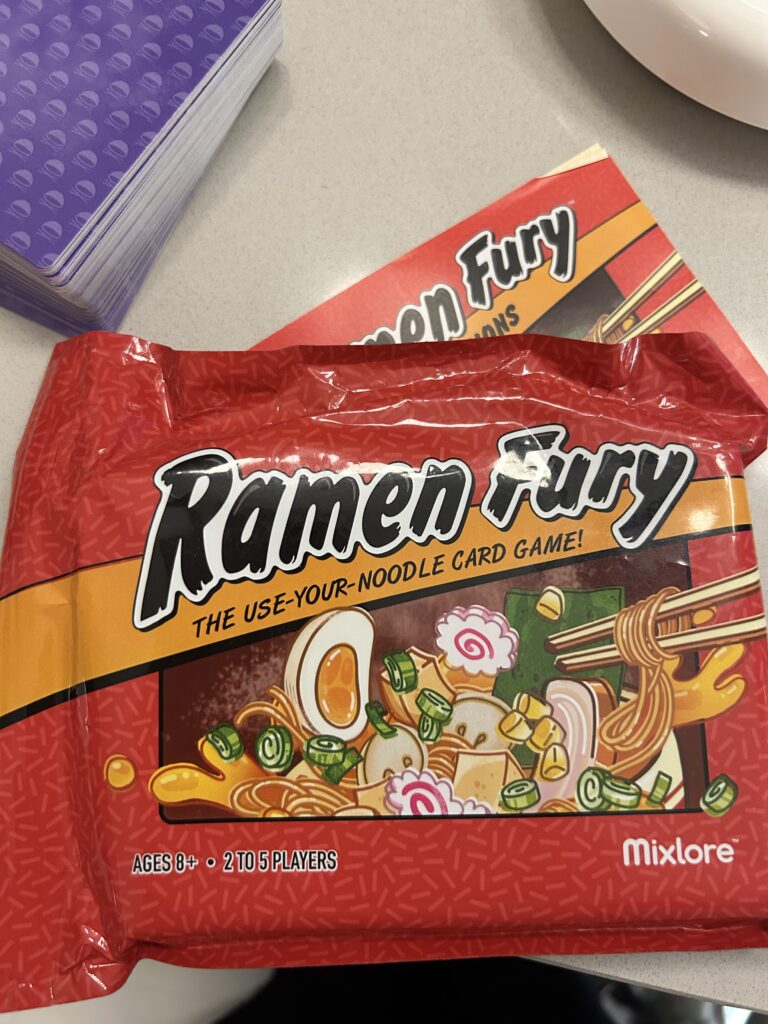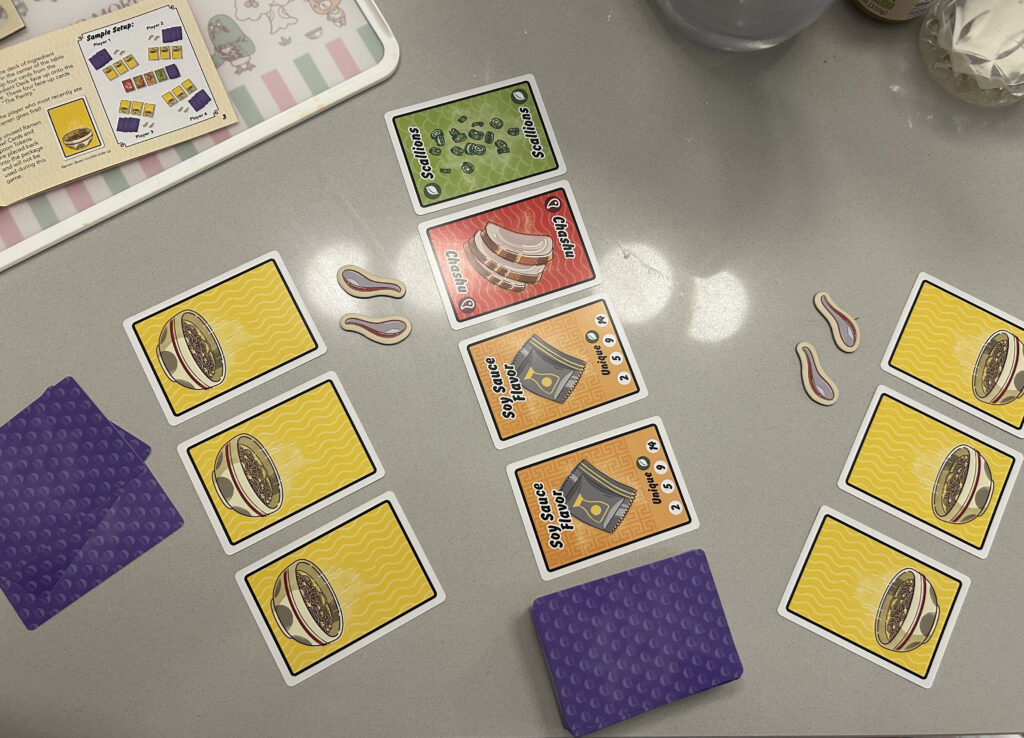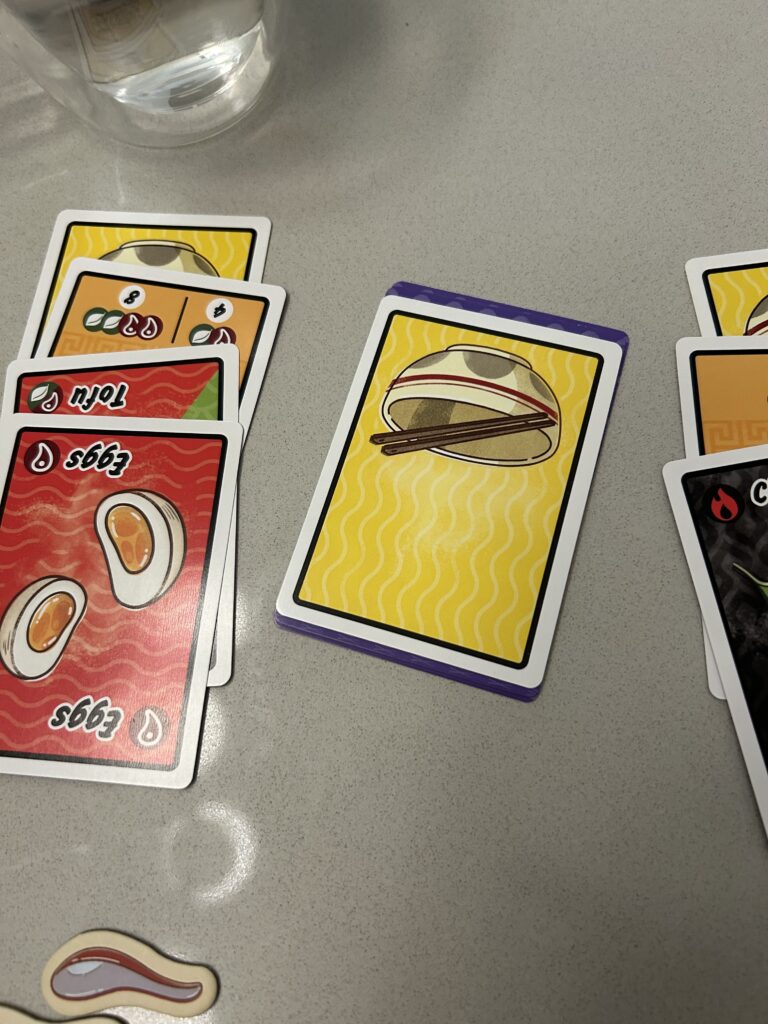When I first saw Ramen Fury a while ago at a friend’s house, I was beyond confusion – why did they put a bag of ramen next to games like Cards Against Humanity and Codenames? Shouldn’t it go in the pantry? Wanting to help, I picked up the bag of ramen only to realize that it was actually a board game – seriously, it even comes in a re-sealable package that you have to cut open with a scissor first, and it looked really similar to a pack of shin ramen.

This is the first of the many things in which Ramen Fury succeeded – the theme. From the packaging to the design of individual cards, the play experience of Ramen Fury, centered around the core mechanics of “building” and “eating” your own ramen bowls, benefits significantly from well-crafted thematic elements that create immersive play.
Gameplay
Ramen Fury is a game that can be played by 2-5 players. Fundamentally, winning Ramen Fury is about both resource acquisition and consumption.

In order to win, players must take draw cards from a “pantry” of four ingredient cards, and play them by stacking ingredient cards on top of the three ramen bowls in front of them. There are different types of “flavor pack” ingredients that serve as the soup base and determines the type of resource cards (protein/veggies/chili pepper, etc.) to be played on top for maximum scores. Some other actions players can use include re-stocking the pantry (discard the four cards at once and re-draw them), playing nori or chili pepper cards that could be used to sabotage other player’s ramens (since there can only be a maximum of 5 ingredients in a bowl, you can add unwelcome ingredients to your opponents bowls to prevent them from scoring higher), dumping one of your bowls by discarding everything (often done when sabotaged), and using one of the two spoon tokens that a player gets per game to scoop an ingredient from any bowl to another.

Apart from this battle of resource collection, Ramen Fury also has a mechanic that prevents players from dragging out a game for too long. In order to properly “score” a bowl of ramen, the player must use one of their two actions per turn to “eat” a bowl with which they are satisfied, turning the entire deck of ingredients upside down.


Once one of the players has eaten all of their three bowls, the rest of the players only get one more round. This rule adds urgency to play, and requires players to always remain vigilant and track other people’s progress, making sure that they don’t fall behind by dumping too many ramen bowls and failing to plan ahead.
Ramen Fury is an interesting combination of hand management, resource collection, and competition. As the game can be played by 2-5 players, I have tried playing this game with both the minimum and maximum number of players – the play experience was vastly different, especially regarding the sabotage and spoon mechanics. When the game is being played with two players (shown in the pictures above), we ended up only using one of our spoon “steal” actions as the freedom for strategizing becomes smaller with only one opponent to whom sabotage can occur and from which resources can be stolen. In a game of 5, however, the battlefield is much more open. Players are constantly taking stuff from others, and the joy of revealing a “chili pepper” card and deciding whose ramen to sabotage as your opponents anticipate in fear are just some of the experiences that cannot be realistically achieved with fewer players. The game is probably still best played with 5 players for the best experience.
Conclusion
Ramen Fury stands out to me among the board games I’ve played as a uniquely themed and engaging family card game. Its clever design, from the ramen packet-like packaging to the intricate gameplay, brilliantly captures the spirit of building ramen bowls. The game’s blend of strategy, resource management, and competitive play mechanics make it a versatile and enjoyable experience. Whether playing with the intensity of a full five-player match, where the game’s sabotage and resource-stealing elements come to full life, or in a smaller, two-player setting, Ramen Fury is able to offer a delightful and flavorful play experience, with its rules reaching a satisfying balance between complexity and fun. Ramen Fury‘s rich thematic presentation celebrates ramen culture in a shared experience that leaves behind lots of laughters and great memories. (I am really bad at this game, but I still had fun!)